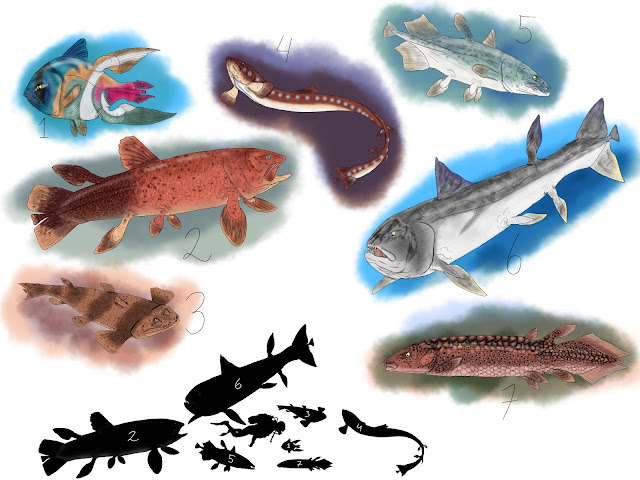1. Family: Brachysomatidae. The Barchysomatids are generally small to medium sized, vaguely disc shaped fish that inhabited the early reefs between 19 and 26 m.y. P.I.. Due to their short bodies, their pelvic fins were pushed forward, close to the skull. It’s the descendants of these small reef fish that would lead to the Bunnyfish and eventually, the Flattacanths.
2. Family: Inermonatatoridae. These toothless coelacanths are rather basal, first appearing 5 m.y. P.I. and the were among the first filterfeeding fish of Eryobis. In the beginning they were small, but as competition got more severe, they became huge. The freshwater Red Giant pictured above is the largest member of this family and subsequently, also one of the last. This family went extinct by 17 m.y. P.I. due to competition and predation.
3. Family: Eurygnathidae. The Wideocanths, as they have been nicknamed, were nature’s first attempt at making a flat coelacanth. They did not last long though, as they were purely marine bottom dwellers, without the ability to breathe air, that evolved before plants had even fully colonised land and so they had no escape from a massive anoxic event that sterilised much of the worlds seas. The wideocanths went extinct by 25 m.y. P.I..
4. Family: Gyrinenchylidae. The Eelacanths, as they are called were a successful group of eel like fish that were among the first to adapt to life in the deep. Evolving long bodies for squeezing through rocks and caverns, once they left the deep for more shallow waters, they quickly diversified and thrived for millions of years. They evolved into many different shapes and sizes over their 70 million year existence, but the species pictured above is quite primitive and would’ve lived between 16 and 23 m.y. P.I..
5. Family: Oblongocaudidae. The Oblongocaudids were close relatives of the Brachysomatids, but split off before the latter became reef specialists. The Oblongocaudids were the first to extend the middle caudal fin and even though this is not unique to them, they were the first to do it. The family lasted from 18 to 30 m.y. P.I..
6. Family: Coelosphyraenidae. The Coelosphyraenids were the first pelagic apex predators of Eryobis. First appearing around 7 m.y. P.I. they spent the next 22 milion years at the top of the food chain, after which they became outcompetes by newer predators. The species illustrated is one of the biggest members of the family would’ve haunted the oceans from 15 to 21 m.y. P.I..
7. Family: Rokanizidae. The Rokanizids were probably the Eryobean first fish to become fully herbivorous. Grazing plants on the bottom, they mostly thrive in freshwater were predators are fewer, although saltwater members are not uncommon. They first appeared 5 milion years P.I. and amazingly enough, their descendants have managed to survive to this day, although not completely unchanged.




No comments:
Post a Comment